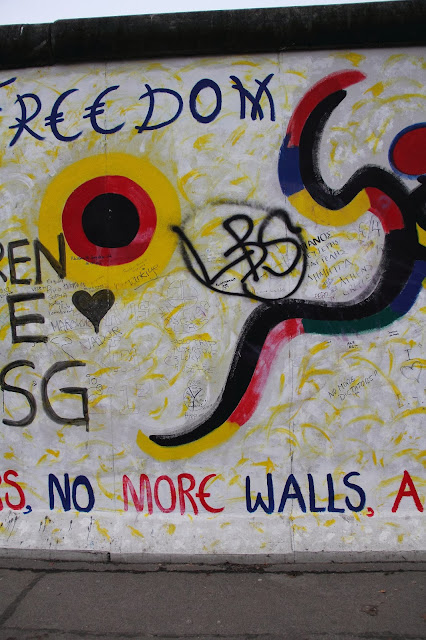Several hundred meters of the Berlin Wall still exist. While in much of the city, all traces of the appalling structure have been erased, at the East Side Gallery enough of the original concrete slabs of oppression have been left vertical for the tourist to marvel, the Berliners to remember - and the graffiti artists to paint. It's hard to imagine what it must have been like to live in a city partitioned against the will of the population. This was no 'peace wall' designed to separate warring factions, but a political imposition upon a people who neither liked it, nor wanted it.
As a child of the Cold War era, The Berlin Wall was something I was aware of from very young days. My two-dimensional hero of children's literature, "Biggles" was always fighting against equally two-dimensional villains who were invariably German. In the WWI tales, Biggles nemesis Erich von Stalhein was a nationalistic German flying ace. By the time the second war occurred he was an ideological Nazi, by the 1950s von Stalhein had morphed again into an East German communist, who also was involved in crime (to mirror Biggles postwar move into the police!). My first impression of the Berlin Wall undoubtedly involved Biggles and his team making a daring spying raid over it, under the nose of von Stalhein himself. The unsubtle cliche's of such books presented the land to the East of the wall as a shadowy world of tyranny and oppression - which history has revealed to be uncomfortably close to the truth in many ways.
To Westerners the sombre concrete division was always known as the "Wall". In Eastern political-speak it was the Anti-Fascist Protective Measure, as in Stalinist thinking (and Ulbricht was nothing of not a true Stalinist), the presence of West Berlin was a colonial threat to the peoples State. Two previous blockades of West Berlin and ensuing international crises were formalised in 1961 when during the night of 13th Aug, DDR troops rolled barbed wire and building materials out along the dividing lines between the sectors. The relatively free movement of people and goods between sectors was proving to be a terrible drain on East Germany who lost vast numbers of people in a Western migration in search of the democratic freedom and economic prosperity unavailable in the East.
Ulbricht, his deputy Honecker and his Soviet overseer Nikita Kruschev, decided to seal off West Berlin with a permanent impermeable barrier, that would make the western city imprisoned within walls, an island surrounded by a red sea of Marxism-Leninism. West Berlin would prove to be a very strange kind of prison however, as it was one which people seemed willing to risk their lives breaking into.
"One Day We'll Be In Charge"
On the East side of the wall there were the infamous kill-zones, the searchlights, trip-wires, attack dogs and gun emplacements. Would-be escapees were not allowed up to the wall itself. Not so in many places on the Western side and the squalid concrete panels were consistently targeted by Western graffiti artists who painted their pictures and slogans as fast as the authorities could whitewash them away. This fine tradition of defiance is celebrated at the East Side Gallery where artists can now approach both sides of the wall. The image above of a Trabant smashing through the wall is particularly striking. There was one successful early escape when a vehicle rammed right through the wall from the East - but it involved a digger rather than a Trab - which would undoubtedly have fared less well on impact!
"No More Walls"
An artist sketching out his lines for his panel
This piece of wall may be a bustling tourist trap today, where in summer mounds of sand are dropped to create a beach-party atmosphere by the banks of the River Spree; but in quiet moments it still has the ability to cast a sinister air over the place. It is still possible to imagine desperate people planning a way through these kill-zones in search of freedom, while the more cautious hung back and willed them to succeed.
Having recently read some moving, and disturbing accounts of both successful and failed escapees; standing under the wall and looking up at its 'anti-climb' coving at the top was as remarkable an experience as touching the wall itself. It may be stating the obvious, but this wall, and all that it represents will be mentioned whenever a history of the 20th Century is written. In my childhood world atlas there was a page in which all the western-orientated countries were blue, while all who were orientated around Moscow or Beijing were coloured Red. The whole world it seemed was red or blue for half a century of potentially terminal conflict. The most interesting points on that map were always where the Red and the Blue met, such as where the 39th parallel runs through Korea - or where a grotesque concrete was wall thrown up to keep Berliners apart. The image of the fall of communism, which will endure for centuries to come, will not be some Hungarian dictat which opened the border to Austria (which actually started the final rusting-through of the iron curtain), but of jubilant Berliner's astride this wall.
"Escape is a mighty method to destabilise dominion"
Honecker used to boast that the wall would be there in centuries to come. This was a strange boast, as it somewhat suggested that he knew that the GDR would never gain legitimacy in the eyes of its people and would have to hold them captive for generations. Surely such statements were tacit admissions or failure rather than actual belief in his own bizarre reasoning and Leninist rhetoric? In a remarkably short period of time, both the Eastern State and its appalling wall were gone. The route of the wall is largely obscured in Berlin today. The watchtowers and barbed wire are gone, the dogs and their masters have departed, the bricked-up windows re-opened; while fuelling the building boom has replaced surveillance as the occupation of choice for career-savvy Berliners. The route is marked in many places by a simple row of cobbles, which act as a reminder of the wall which once tore this city apart.


















No comments:
Post a Comment